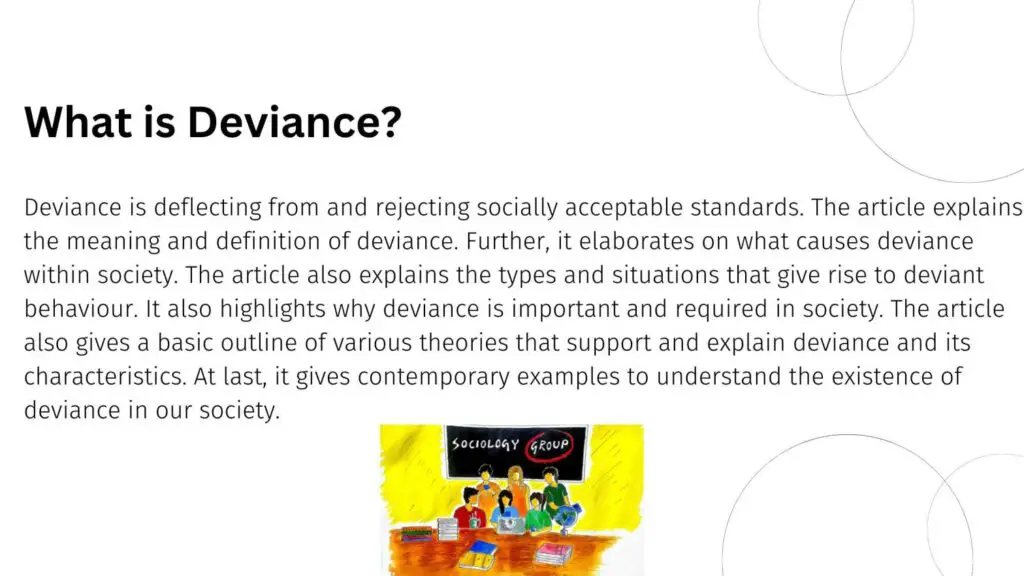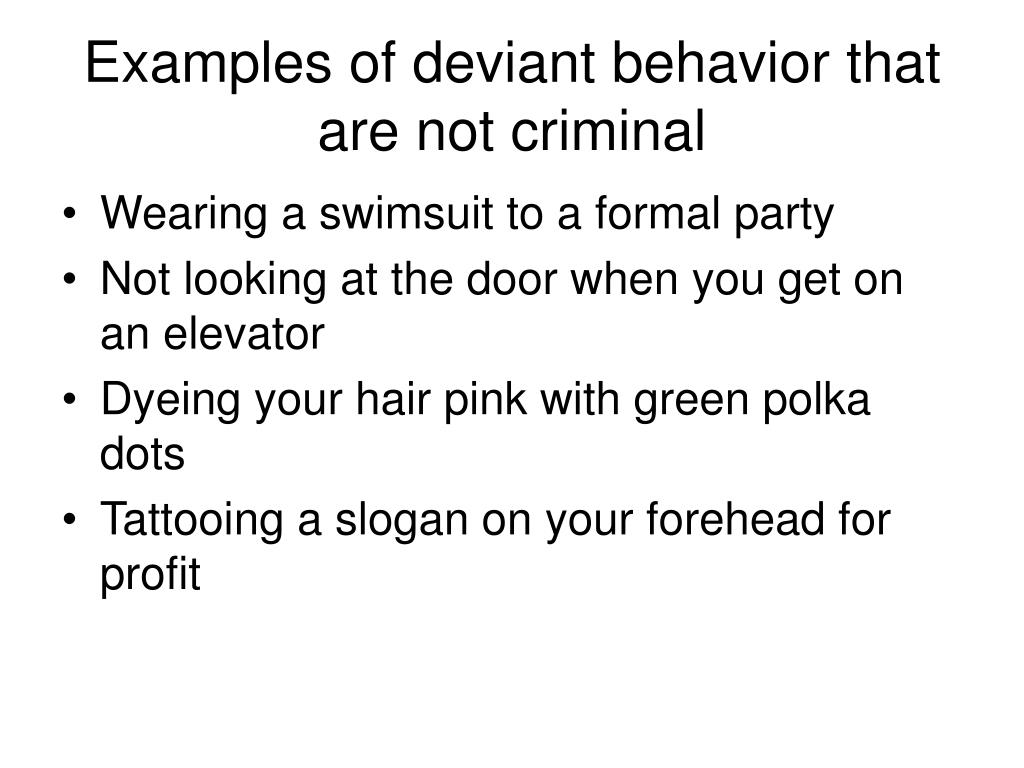Have you ever felt a pang of guilt after cutting in line at the grocery store? Or perhaps found yourself daydreaming about winning the lottery instead of focusing on your work? These everyday transgressions, while seemingly harmless, fall under the umbrella of deviant behavior. But what exactly does this term encompass, and how does it differ from criminal activity?

Image: ar.inspiredpencil.com
Deviant behavior, simply put, refers to any action that violates social norms and expectations. It’s a vast and multifaceted concept, encompassing behaviors that range from the mildly disruptive to the profoundly disturbing. This article delves into the intriguing world of non-criminal deviant behavior, exploring its various manifestations, societal impacts, and the often-complicated moral considerations surrounding it.
Understanding the Nuances of Deviance
To grasp the essence of deviant behavior, let’s first address the concept of social norms. These are unwritten rules and expectations that govern how individuals should behave within a given society. They’re often deeply ingrained in our cultural fabric, shaping our perceptions of what’s considered “normal” or “acceptable.”
However, social norms are fluid and constantly evolving, influenced by factors such as time, place, and societal values. What might be deemed deviant in one culture or era might be commonplace in another. For instance, wearing revealing clothing was once considered scandalous but is now widely accepted in many Western societies.
Non-Criminal Deviance: A Spectrum of Behaviors
While criminal acts explicitly violate legal codes, non-criminal deviant behavior falls outside the purview of the law. It often involves actions that are deemed morally questionable, inappropriate, or transgressive but don’t carry legal consequences. Here are some common examples of non-criminal deviant behavior:
1. Social Deviance: Breaking Unwritten Rules
- Public displays of affection: While PDA is embraced in some cultures, it can be viewed as inappropriate in others, particularly in public settings.
- Loud and disruptive behavior: Many societal norms dictate appropriate levels of noise and behavior in public spaces. Engaging in loud conversations, playing music at high volume, or interrupting others can be considered deviant.
- Fashion choices: While personal style is often encouraged, certain clothing choices might be deemed socially unacceptable in certain contexts, such as wearing provocative attire to a formal event.
- Gossip and rumor spreading: Sharing personal information without consent, spreading unfounded rumors, or engaging in malicious gossip is commonly perceived as deviant.
- Cutting in line: This seemingly minor act can be viewed as disrespectful and disruptive, violating the unwritten rule of queuing.

Image: www.slideserve.com
2. Ethical Deviance: Questioning Moral Boundaries
- Cheating on exams or assignments: While educational institutions have clear policies against plagiarism and academic dishonesty, these actions often fall under the category of ethical deviance.
- Lying to friends or family: Deceiving close relationships can strain trust and erode the foundation of the relationship, even if no legal consequences arise.
- Taking advantage of others: Exploiting individuals for personal gain, whether through manipulation, deception, or taking unfair advantage, can be categorized as ethically deviant behavior.
3. Cultural Deviance: Challenging Norms
- Religious practices: Certain religious practices, such as polygamy or the use of hallucinogenic substances in rituals, may be deemed deviant in contrast to mainstream societal norms.
- Alternative lifestyles: Individuals who identify as LGBTQ+ or choose alternative living arrangements, such as communes or intentional communities, might encounter societal disapproval or marginalization.
- Artistic expression: Some forms of art, particularly those that challenge traditional aesthetics or societal taboos, can be labeled as deviant and may face censorship or criticism.
4. Psychological Deviance: Mental Health Considerations
- Obsessive-compulsive disorder (OCD): Individuals with OCD may engage in repetitive behaviors or rituals that are perceived as odd or unusual by others.
- Social anxiety disorder: Excessive shyness, fear of social interaction, and avoidance of social situations can be perceived as deviating from typical social norms.
- Body dysmorphic disorder (BDD): Individuals with BDD may engage in behaviors aimed at concealing perceived flaws or imperfections, such as excessive grooming or avoidance of social situations.
The Gray Areas: Exploring the Complexity of Deviance
While the examples above offer a glimpse into the diverse forms of non-criminal deviant behavior, it’s crucial to acknowledge the inherent fluidity and subjectivity of this concept. What’s considered deviant in one context may not be seen as such in another. The same behavior can be perceived differently based on cultural norms, social expectations, and personal values.
For instance, a young adult who prefers to live with their parents after graduating college might be viewed as deviant in a society that embraces individual autonomy and self-sufficiency. However, in cultures that prioritize familial ties and support, this behavior could be considered perfectly acceptable.
The Impact of Deviance on Society
Deviant behavior, both criminal and non-criminal, can have profound impacts on society. While some forms of non-criminal deviance may be harmless or even beneficial (e.g., challenging societal norms to spark progress), others can lead to social unrest, conflict, or harm.
However, it’s crucial to avoid generalizations or sweeping judgments. Not all deviant behavior is negative, and not everyone who engages in deviant acts is inherently “bad.” It’s essential to approach these topics with sensitivity, understanding, and a nuanced perspective.
Navigating the Ethical Landscape: Responsibility and Tolerance
In a world where societal norms are constantly evolving, it’s imperative to navigate the ethical landscape with careful considerations. While we should strive for tolerance and understanding, we also have a responsibility to uphold ethical principles and promote positive social change.
If someone’s non-criminal deviant behavior is causing harm to others or undermining societal stability, it’s important to engage in constructive dialogue and address the underlying concerns. It’s crucial to remember that judgments should be based on individual actions and circumstances, not on blanket stereotypes or prejudices.
Non Criminal Deviant Behavior Examples
Looking Ahead: A Call to Action
As we navigate the complexities of non-criminal deviant behavior, it’s crucial to foster open and honest conversation. By challenging preconceptions, promoting empathy, and recognizing the fluidity of societal norms, we can create a more inclusive and understanding society.
It’s time to move beyond simplistic labels and embrace the richness of human experience, acknowledging the spectrum of behaviors that make up our collective tapestry. Instead of focusing solely on what we deem “deviant,” let’s work together to cultivate a society that celebrates diversity, embraces difference, and encourages responsible and ethical conduct.






